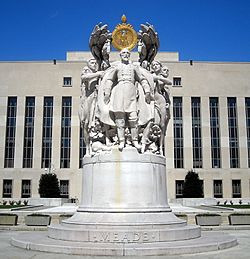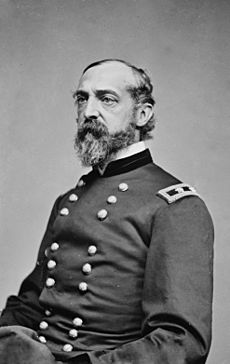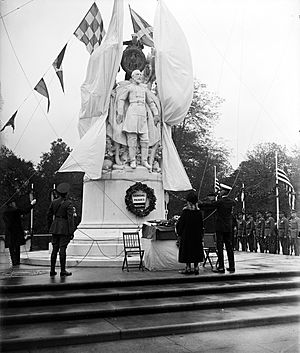George Gordon Meade Memorial facts for kids
 |
|
| Coordinates | 38°53′32″N 77°00′59″W / 38.892131°N 77.016444°W |
|---|---|
|
George Gordon Meade Memorial
|
|
|
U.S. Historic district
Contributing property |
|
| Part of | Civil War Monuments in Washington, D.C. |
| NRHP reference No. | 78000257 |
| Added to NRHP | September 20, 1978 |
| Location | 300 block of Pennsylvania Avenue NW, Washington, D.C., United States |
| Designer | Charles Grafly (sculptor) Grant Simon and Edward P. Simon (architects) Piccirilli Brothers (carver) George A. Fuller Company (contractor) |
| Material | marble and granite (sculpture) granite (base) |
| Height | 17.10 feet (5.21 m) |
| Opening date | October 19, 1927 |
| Dedicated to | George Meade |
The George Gordon Meade Memorial is a special artwork in Washington, D.C.. It honors George Meade, a military officer from Pennsylvania. He is famous for defeating General Robert E. Lee at the important Battle of Gettysburg during the American Civil War.
This monument stands on Pennsylvania Avenue NW, in front of a courthouse. It was first placed in a different spot called Union Square. Later, it was moved and stored for 14 years before finding its current home. The statue was created by Charles Grafly, a talented sculptor and teacher. Pennsylvania gave this monument as a gift to the nation. Many important people attended its dedication in 1927, including President Calvin Coolidge.
The Meade Memorial is one of eighteen Civil War monuments in Washington, D.C. These monuments were all added to the National Register of Historic Places in 1978. The sculpture is made of marble and granite. It shows Meade and seven symbolic figures. It sits on a granite base in a public park. The National Park Service takes care of the monument.
Another monument to General Meade is on the Gettysburg Battlefield. It was dedicated in 1896. This one shows Meade on horseback and was the first of its kind at Gettysburg.
Contents
Discovering General George Meade's Story
George Meade (1815–1872) was a military officer from Pennsylvania. He is best known for being a Union general during the American Civil War. He finished his studies at the United States Military Academy at West Point in 1835. He served briefly in the Army during the Second Seminole War.
Meade then worked as a civil engineer for railroad companies. He also worked for the United States Department of War. He rejoined the army in 1842. Meade fought in the Mexican–American War. He was promoted for his brave actions at the Battle of Monterrey. Before the Civil War began in 1861, Meade designed lighthouses. He also surveyed coastlines for the Corps of Topographical Engineers.
At the start of the Civil War, he became a brigadier general. He was hurt at the Battle of Glendale in 1862. After recovering, he led troops in major battles like Antietam and Fredericksburg. In June 1863, Meade took over from General Joseph Hooker. He became the leader of the Army of the Potomac.
Days later, he fought his most important battle at Gettysburg. This was the bloodiest battle of the war. He defeated General Robert E. Lee and the Confederate forces. However, President Abraham Lincoln criticized him for letting the Confederates escape. Meade continued to lead the Army of the Potomac until the war ended. But Ulysses S. Grant was made general-in-chief of all Union armies.
Creating the Meade Memorial
After Meade died in 1872, there wasn't an immediate demand for a memorial. He wasn't as popular with leaders like Lincoln or Grant. But in his home state of Pennsylvania, he was seen as a hero.
In the 1910s, groups like the Grand Army of the Republic (GAR) wanted a statue of Meade. They asked the Pennsylvania General Assembly to pay for it. The state agreed in 1913 and set aside $200,000. Pennsylvania lawmakers also asked Congress to approve the statue. Congress agreed in 1915. They said the design and location had to be approved by the United States Commission of Fine Arts (CFA).
A special commission was set up in Pennsylvania to oversee the project. This group had some disagreements, which caused delays. After some time, they chose Charles Grafly (1862–1929) as the sculptor. Grafly was from Pennsylvania and was known for his portrait busts.
The CFA was a bit unsure about Grafly at first. His symbolic artworks were sometimes hard to understand. But after some talks and changes, his design was approved in 1918. Grafly received $85,000 for his work. After more discussions about the design and where to put it, a groundbreaking ceremony happened in 1922. The chosen spot was in Union Square, near the large Ulysses S. Grant Memorial. The total cost for the memorial was $400,000.
Dedication Ceremony of the Memorial
The Meade Memorial was officially dedicated on October 19, 1927. It was one of the last Civil War monuments built in Washington, D.C. By this time, many of the people who first wanted the memorial had passed away. Only a few Civil War veterans were able to attend the ceremony.
Important guests included President Calvin Coolidge and his wife, Grace. Pennsylvania Governor John Stuchell Fisher was also there. Other attendees included the Secretary of the Treasury, Andrew W. Mellon, and Senator Simeon D. Fess. White tents were set up around the memorial for guests. They were decorated with greenery and flags.
The ceremony began with prayers. Governor Fisher gave a speech about Meade's life. Then, Meade's daughter, Henrietta, unveiled the memorial. As it was revealed, pigeons were released. This symbolized peace. The United States Army Band played "The Star-Spangled Banner" as cannons fired.
Governor Fisher presented the memorial to President Coolidge. Coolidge accepted it on behalf of the American people. He spoke about Meade's role in saving the nation. He also mentioned that the conflict was over and peace had arrived. An elderly veteran who fought at Gettysburg gave a speech. He was helped by others when he felt unwell, but he finished his speech to cheers. The ceremony ended with the band playing "Taps".
Later Years and Location Changes
In 1969, the memorial was taken apart. It was put into storage when a new highway tunnel was built. It stayed in storage for many years. People wondered why it hadn't been put back.
Eventually, the sculpture was repaired. It had cracked in several places. In 1983, it was placed in a new park on Pennsylvania Avenue NW. A new dedication ceremony took place on October 3, 1984.
The Meade Memorial is one of many Civil War monuments in Washington, D.C. It was added to the National Register of Historic Places in 1978. It was also listed on the District of Columbia Inventory of Historic Sites in 1979. The National Park Service owns and maintains the memorial and the park around it.
Another monument to Meade is on the Gettysburg Battlefield. It was designed by sculptor Henry Kirke Bush-Brown. This monument was dedicated in 1896. It shows Meade on horseback. It was the first equestrian (on horseback) monument at Gettysburg. It is one of hundreds of monuments there.
Understanding the Memorial's Design
The Meade Memorial is located on Pennsylvania Avenue NW in Washington, D.C. It stands in front of the E. Barrett Prettyman United States Courthouse. It is in the middle of a public park.
The sculpture is made of marble and granite. It is 10.6 ft (3.2 m) tall and 9 ft (2.7 m) wide. General Meade is shown in his military uniform at the front. On the back, there is a winged figure representing War. This figure is next to two memorial tablets.
On the sides of the sculpture are six symbolic figures. These figures represent qualities that the artist believed a great military leader should have. They are: Chivalry, Energy, Fame, Loyalty, Military Courage, and Progress.
- The male figure of Loyalty and the female figure of Chivalry are shown removing Meade's military cloak. This symbolizes the "cloak of battle" that Meade leaves behind.
- Loyalty holds a wreath and garlands, showing Meade's achievements.
- Fame is behind Loyalty, supported by Energy.
- Behind Chivalry are Progress and Military Courage. Military Courage is linked with War.
At the very top of the memorial is a gold finial. It shows the state seal of Pennsylvania. The base of the monument is made of pink granite. It is 7.4 ft (2.3 m) tall and 20.10 ft (6.13 m) wide.
The memorial has several inscriptions:
- CHARLES GRAFLY. SC. / MCMXX–MCMXXV (on the sculpture, showing the sculptor and years of creation)
- MEADE (on the lower front of the base)
- EDWARD P. SIMON / GRANT M. SIMON / ARCHITECTS / EXECUTED BY PICCIRILLI BROS (on the rear of the base, showing the architects and carvers)
- THE COMMONWEALTH / OF PENNSYLVANIA / TO MAJOR GENERAL / GEORGE GORDON MEADE / WHO COMMANDED / THE UNION FORCES / AT GETTYSBURG (in brass letters on the granite platform, explaining who the memorial is for)
See also
 In Spanish: Monumento conmemorativo a George Gordon Meade para niños
In Spanish: Monumento conmemorativo a George Gordon Meade para niños




